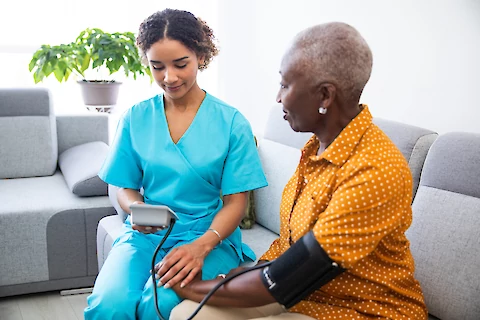
February is American Heart Month—a time when we put a spotlight on one of the most crucial aspects of our health: our heart. Maintaining heart health is paramount, with blood pressure playing an integral role.
Senior Helpers Milford-Franklin has a comprehensive guide to help you understand not just how to accurately take a senior's blood pressure, but also why this is important, what the readings mean, and what to do with the information.
Understanding Blood Pressure
Blood pressure is the force applied by the bloodstream on the walls of the arteries as the heart pumps blood around the body. It's given as two figures - systolic pressure (when the heart beats) over diastolic pressure (when the heart rests).
For a senior, a normal reading is around 120/80 mmHg. However, blood pressure can fluctuate with stress, diet, medication, and illness. Chronic high or low readings can indicate underlying health conditions such as hypertension or hypotension, which warrant medical attention.
Importance of Accurate Blood Pressure Measurement
Accurate blood pressure measurement is vital to track health and prevent complications. Wrong readings could lead to misdiagnosis, unnecessary medication, or a missed opportunity for essential early intervention. Regular measurement can help detect and manage health issues early, ensuring the senior's well-being.
Step-by-Step Guide to Measuring Blood Pressure
To measure blood pressure, you will need a home blood pressure monitor. A device with an upper arm cuff, rather than a wrist or finger device, is recommended for accuracy.
Make sure the senior is relaxed. Let sit for 5-10 minutes in a quiet room before taking the measurement. They should be seated comfortably with feet flat on the floor and back supported. The arm should rest on a flat surface at heart level.
Place the cuff on the senior's upper arm and follow the instructions on the device. Press 'start' and wait as the cuff inflates and deflates. A reading will appear on the screen. For accuracy, take at least 2-3 readings each time, waiting for one minute between each reading.
Interpreting Blood Pressure Readings
Blood pressure readings include two numbers. The top one is the systolic pressure, and the bottom one is the diastolic pressure. Readings around 120/80 mmHg are considered normal. Readings above 130/80 mmHg are considered high, while readings below 90/60 mmHg are considered low.
Using Blood Pressure Information
The blood pressure readings you gather will be most useful if tracked over time to identify patterns rather than focusing on isolated results. Document these readings, noting the date, time, and any additional relevant information like recent physical activity or anxiety.
Share this log with the senior's healthcare provider. This information helps them to make informed decisions about the senior's health and, if necessary, adjust treatment plans. While measuring blood pressure at home can help monitor health, it's not a substitute for regular check-ups with a healthcare provider.
Senior Helpers Offers Custom Senior Care
Keeping tabs on a senior's blood pressure is pivotal for their heart health, particularly during American Heart Month. With this guide, caregivers can accurately monitor blood pressure, interpret the readings, and utilize that information. Not only does this support a senior's well-being, but it also gives caregivers a sense of understanding and control over the senior's health.
Are you looking for professional aid with senior care in Milford, Franklin, Webster, Foxboro, or Sharon? At Senior Helpers Milford-Franklin, we are dedicated to providing the best comprehensive care and assistance for seniors. Contact us today to learn more about our services!